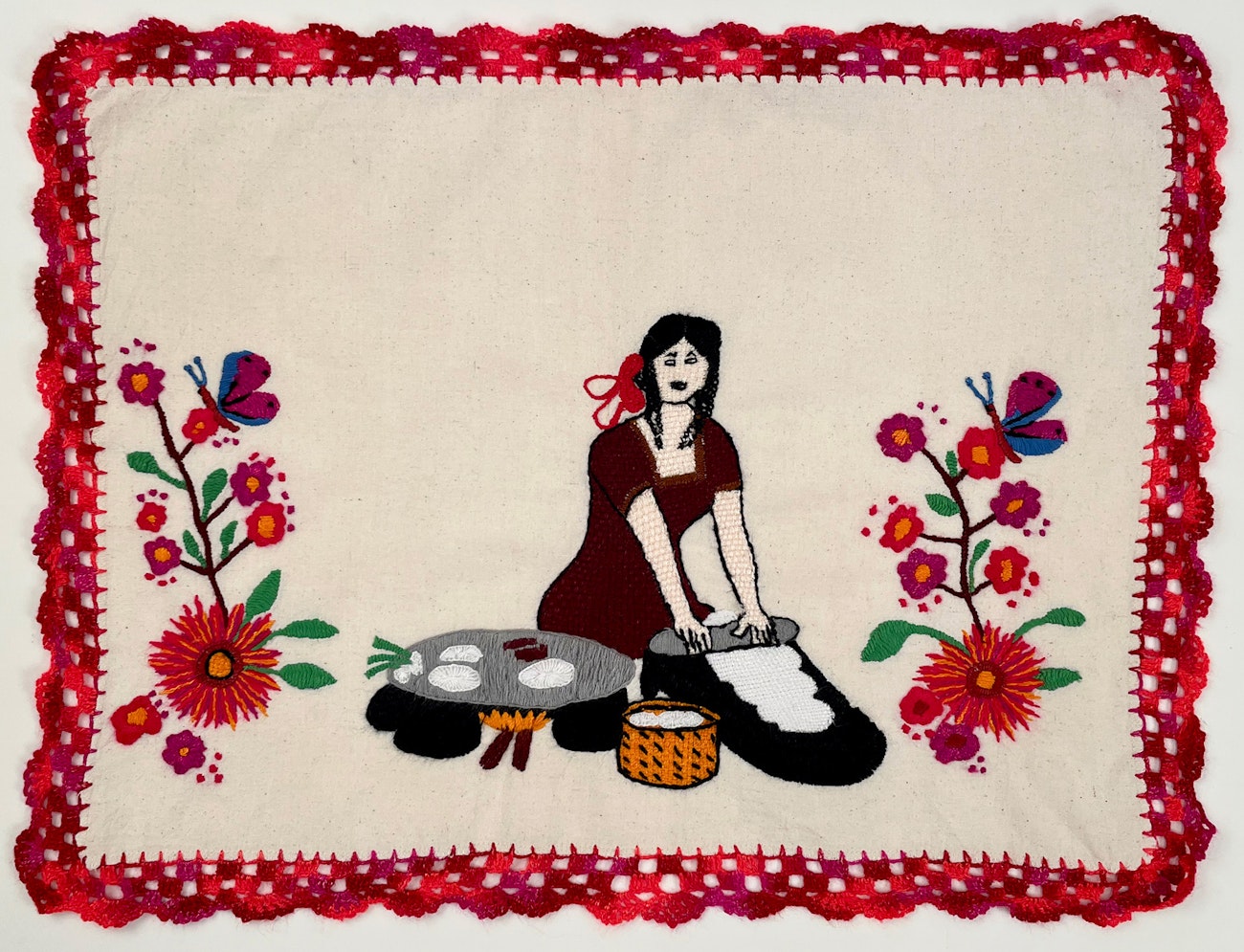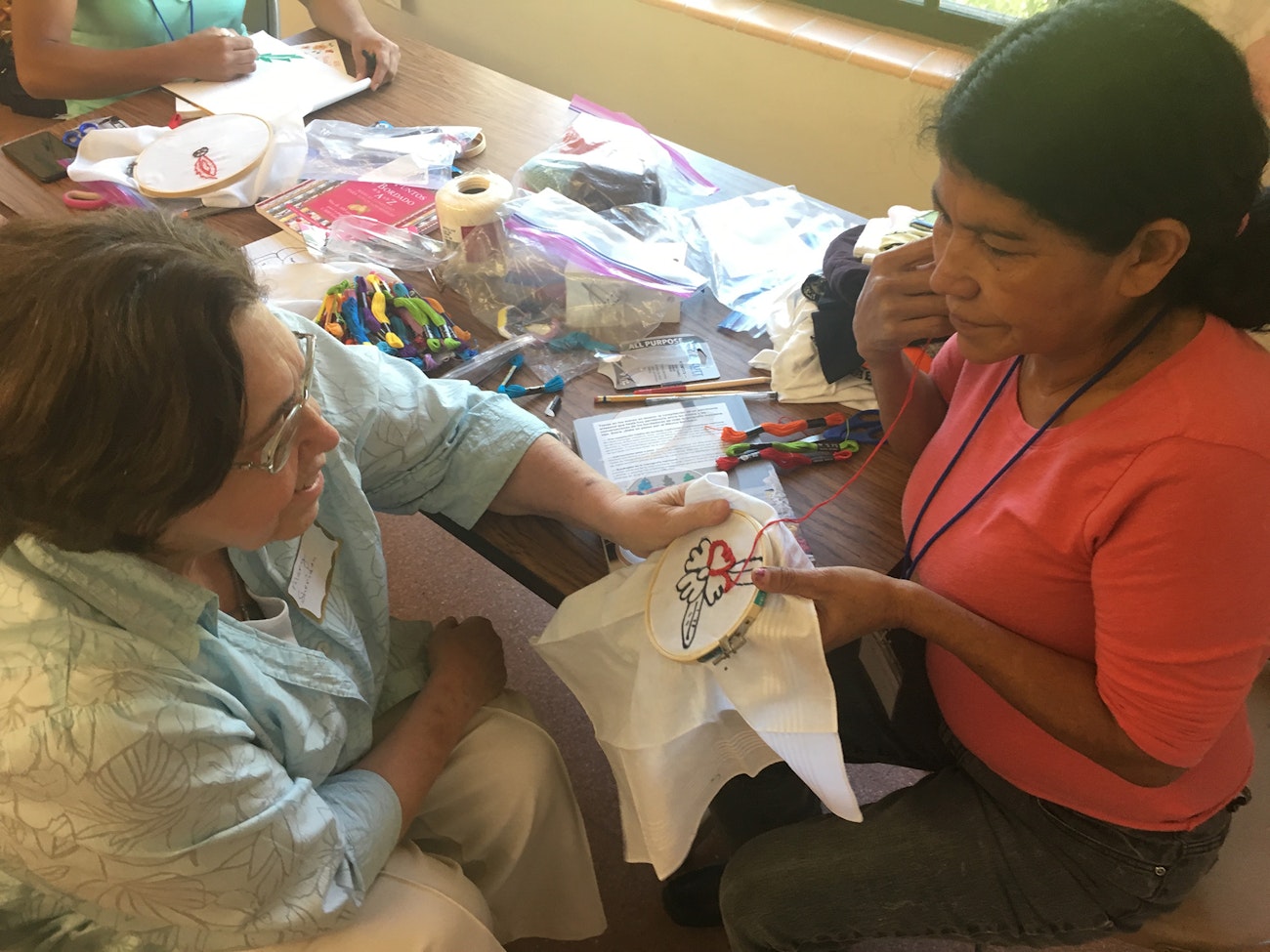When you are fleeing for your life, what can you carry? What do you keep when you discover that you can’t carry even the little you have brought? You bring your hands. You keep what you learned from your mother and her foremothers.
Three Rooms
I’m in the dining room, el comedor, of a migrant shelter in Tucson, Arizona. Founded by Catholic Community Services and supported by a generous outpouring from the community, the repurposed monastery accommodates asylum seekers released by the US Immigration and Customs Enforcement (ICE) and Customs and Border Protection (CBP). The shelter provides food, clothing, a shower, and a bed for two or three nights until the migrants can connect with sponsors and move to their final destinations. I have sorted donated clothes, taught a few “emergency English” classes, and helped pull together a rudimentary chapel.

Design and embroidery by Faviola M., who says, “I am embroidering a memory of how it was in my house—how we cooked before electricity.” This piece was included in an Artisans Beyond Borders national exhibition entitled Bordando Esperanza ~ Embroidering Hope: Retablos of Asylum
Today, my friend Valarie Lee James has persuaded me to spend time with a group of women who are embroidering. Val has long been a collector of desert-found mantas, hand-embroidered cloths that are often used to wrap food and that can be found along migration corridors. These small textiles are given as farewell gifts to those headed north to the United States’ southern border, including the migrants who don’t come via official routes. When crossing the desert, asylum seekers can lose everything, even their lives. Val has an altar in her home with the mantas, honoring them.
At the shelter in Tucson, Val has a basket with cloth, thread, embroidery hoops. We don’t need to speak our pitiable Spanish; women follow her into the dining room when they catch sight of the handwork supplies.
Val shows me a manta-in-progress, left behind on one of the many migration routes. This small cloth is finished except for an incomplete crochet border. I shake my head. I can do basic crochet, but this isn’t basic. Many of these everyday textiles display extraordinary skill. “What are we going to do with it?” Val asks. She shows it to one of the women, who smiles as she picks up a crochet hook and gets to work. Her hands remember.
Months later, Val and I are in a second room. This room is in Nogales, Mexico, at a shelter in sight of the border wall. Here, women are waiting, waiting, waiting to be processed for legal immigration into the United States. The shelter is improving: the women’s dorm now has a wall, and volunteers brought tables and chairs so families no longer sit on the floor. Val has brought her workbasket, and the women sit around a table embroidering. Some have children on their laps, and when the children fuss, mothers pull out a full breast. Val has news: we can sell the mantas the asylum seekers are making as they wait. Selling the work provides income, but it is more than that. As the women stitch, they create depictions of home, of beauty, of faith.

Mary discusses a developing pattern with an artisan.
They say that the body remembers trauma, and I believe it. Past horrors are carried in muscle memory and in the dark unconscious corners of the brain. But hands carry the memory of skills handed down over generations. Women gather in groups to work together, to help each other, and to find strength and beauty and power in often-disregarded women’s work. That, too, lives in the unconscious corners of the brain.
Now I am in a third room, and many months have passed. Our project of purchasing and reselling mantas has grown. Val and I offer the embroideries for sale online to raise funds for the migrants. I am one of the lucky ones; I get to package up the mantas created by the migrant women and mail them to Etsy buyers. We shudder to imagine what the embroiders have been through, but they send us bright flowers, birds, butterflies, hope. The women embroider their truth: “have faith,” “be strong,” “God will take care of you.” I pick up one of the mantas. It needs a little repair to the crochet edging. Travel, washing, ironing take their toll. I find my crochet hook. My hands remember.
Interested in more stories of craft and migration? Check out the Fall 2022 issue of PieceWork.
Also, remember that if you are an active subscriber to PieceWork magazine, you have unlimited access to previous issues, including Fall 2022. See our help center for the step-by-step process on how to access them.
Mary S. Sheridan is Emeritus Professor of Social Work at Hawaii Pacific University. She lives in Tucson, Arizona, where she volunteers with community agencies.

